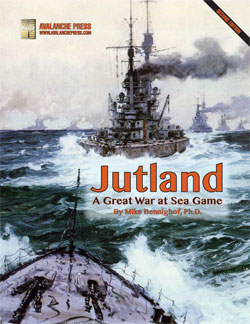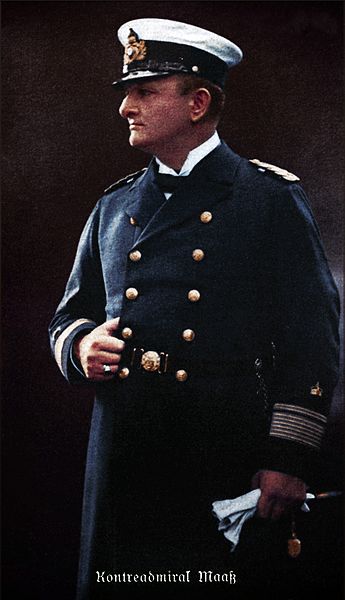| Jutland:
Helgoland Bight, Part One
By Mike Bennighof, Ph.D.
April 2023
 German activity in the North Sea, in particular the raid by German light cruisers on British fishing trawlers on the Dogger Bank, demanded a British response. Commodore Roger Keyes, in charge of submarines in the North Sea, suggested an attack on the German torpedo boats and cruisers that returned each morning from patrolling the Helgoland Bight, the bay between the fortified island of Helgoland and the German naval bases to its south-east. Keyes and Reginald Tyrwhitt, commander of the Harwich destroyer flotillas, met with the Admiralty War Staff on 24 August and received approval for the operation to begin on the morning of 28 August. German activity in the North Sea, in particular the raid by German light cruisers on British fishing trawlers on the Dogger Bank, demanded a British response. Commodore Roger Keyes, in charge of submarines in the North Sea, suggested an attack on the German torpedo boats and cruisers that returned each morning from patrolling the Helgoland Bight, the bay between the fortified island of Helgoland and the German naval bases to its south-east. Keyes and Reginald Tyrwhitt, commander of the Harwich destroyer flotillas, met with the Admiralty War Staff on 24 August and received approval for the operation to begin on the morning of 28 August.
That approval came as the Admiralty, prodded by First Lord Winston Churchill, was in the midst of ordering another poorly-considered project, the deployment of four battalions of mostly-raw Royal Marines to Ostend on the Belgian coast to stop the German advance to the coast. With the landings consuming the War Staff’s attention, the Helgoland operation appears to have received less attention than it deserved.
 Sir Frederick Doveton Sturdee, Chief of the War Staff, would not authorize deployment of the Grand Fleet’s battle cruisers as Keyes had suggested and held that the two battle cruisers of Force K stationed in the Humber estuary would be sufficient, along with the five elderly armored cruisers of Force C that usually patrolled the seas between England and the Netherlands. Not until the 26th did Sturdee see fit to inform Sir John Jellicoe, commander of the Grand Fleet, even though Force K nominally came under his authority. Sir Frederick Doveton Sturdee, Chief of the War Staff, would not authorize deployment of the Grand Fleet’s battle cruisers as Keyes had suggested and held that the two battle cruisers of Force K stationed in the Humber estuary would be sufficient, along with the five elderly armored cruisers of Force C that usually patrolled the seas between England and the Netherlands. Not until the 26th did Sturdee see fit to inform Sir John Jellicoe, commander of the Grand Fleet, even though Force K nominally came under his authority.
Alarmed, Jellicoe immediately ordered the Grand Fleet readied for sea. Sturdee had only provided a very broad outline of the operation’s intentions, and responded to the fleet commander’s requests for more information with further vagaries. The staff chief told Jellicoe that only the battle cruisers and light cruisers would be needed. Jellicoe understood that Sturdee had only been appointed to his position five days before the outbreak of war and was, to be charitable, not up to the task. The Grand Fleet commander accordingly ordered not only the cruisers but the battle squadrons to sea as well. That decisive act would turn potential disaster into a badly-needed victory.
The Harwich destroyers and their flotilla leaders began the sweep at dawn on 28 August, soon joined by the six light cruisers of the Grand Fleet’s 1st Light Cruiser Squadron – a pleasant surprise to the commanders on the spot, who had not been informed of reinforcements coming from the Grand Fleet. Tyrwhitt’s two flotillas numbered sixteen destroyers apiece, each led by a light cruiser (Fearless and the brand-new Arethusa, Tyrwhitt’s flagship). Nine submarines completed the trap.

Tyrwhitt's new flagship, the light cruiser Arethusa.
The day came up with an unexpectedly heavy fog that masked the British deployment. The German patrols consisted of nine modern torpedo boats in the outer ring, backed by nine older torpedo boats that had been converted into minesweepers and made up an inner patrol ring. Supporting them were four light cruisers, including the elderly and essentially useless Hela, originally built as an aviso to carry messages in the days before warships carried wireless gear. Rear Admiral Leberecht Maass, commanding the patrols, had eight other light cruisers theoretically available though all but one were in port at Wilhelmshaven or Brunsbüttel.
For heavy support, Maass had . . . nothing. In the event of a British attack, the light forces were expected to fall back under the heavy guns of the Helgoland fortress, an unsinkable battleship poised exactly in the approaches to the Jade Bay where Wilhelmshaven lay and the Elbe ports including Brunsbüttel. But in the heavy fog the rolled in that morning, the gunners could provide little support.
When German ships had departed on operations over the preceding two weeks, the battle cruisers of Scouting Group One had moved into the Schillig Roads outside Jade Bay and kept up steam. But that only took place during an operation; on the morning of the 28th two battle cruisers (Moltke and von der Tann) were available inside Wilhelmshaven’s harbor, with the third (Seydlitz) undergoing condenser repairs and the large armored cruiser Blücher tied up at the coaling quay. None of the battle cruisers had raised steam in their boilers, and none of the High Seas Fleet’s other heavy ships were detailed to support the patrols.
 And to the fleet’s senior officers, it did not seem necessary. Wilhelmshaven lies perhaps 15 kilometers inland from the open North Sea, on the edge of the broad Jade Bay, and the heavy fog did not appear. The ships waiting there could not easily be deployed; the bar separating the Jade from the open sea only had deep enough water for large ships to pass during certain hours; on the 28th, none of the fleet’s capital ships could cross between 0700 and 1200. Maass (right), his cruisers and the torpedo boats were on their own. And to the fleet’s senior officers, it did not seem necessary. Wilhelmshaven lies perhaps 15 kilometers inland from the open North Sea, on the edge of the broad Jade Bay, and the heavy fog did not appear. The ships waiting there could not easily be deployed; the bar separating the Jade from the open sea only had deep enough water for large ships to pass during certain hours; on the 28th, none of the fleet’s capital ships could cross between 0700 and 1200. Maass (right), his cruisers and the torpedo boats were on their own.
First contact came at 0700, when four British destroyers attacked the torpedo boat G194. She radioed for help, and Franz Hipper, commander of the scouting forces, ordered two of the light cruisers to hunt down the destroyers, instructed the light cruisers still in port to raise steam and sent the zeppelin L3 to scout out the situation. Soon the whole British Third Flotilla, along with Arethusa, was chasing four German torpedo boats toward Helgoland. They radioed the cruisers and the fortress for help, but the island’s gunners could not make out any targets in the mist and feared firing blindly into the fog.
Two of the cruisers, Stettin and Frauenlob, promptly arrived and engaged the two British cruisers leading the charge. Stettin took damage from Fearless, but forced the British cruiser and her destroyers to veer away and allowed the torpedo boats to reach Helgoland. Meanwhile Arethusa and Frauenlob hit one another repeatedly, with the British cruiser taking the worst of the exchange. Having driven off the British, Frauenlob turned back for Helgoland and to both sides it seemed that the battle had ended by 0830. The zeppelin contributed little, spotting one British cruiser through the heavy fog before returning to her base with engine trouble.
Order Jutland second edition here.
Please allow an extra three weeks for delivery.
Sign up for our newsletter right here. Your info will never be sold or transferred; we'll just use it to update you on new games and new offers.
Mike Bennighof is president of Avalanche Press and holds a doctorate in history from Emory University. A Fulbright Scholar and NASA Journalist in Space finalist, he has published a great many books, games and articles on historical subjects; people are saying that some of them are actually good.
He lives in Birmingham, Alabama with his wife, three children, and his new puppy. His Iron Dog, Leopold, could swim very well.
Want to keep Daily Content free of third-party ads? You can send us some love (and cash) through this link right here.
|
